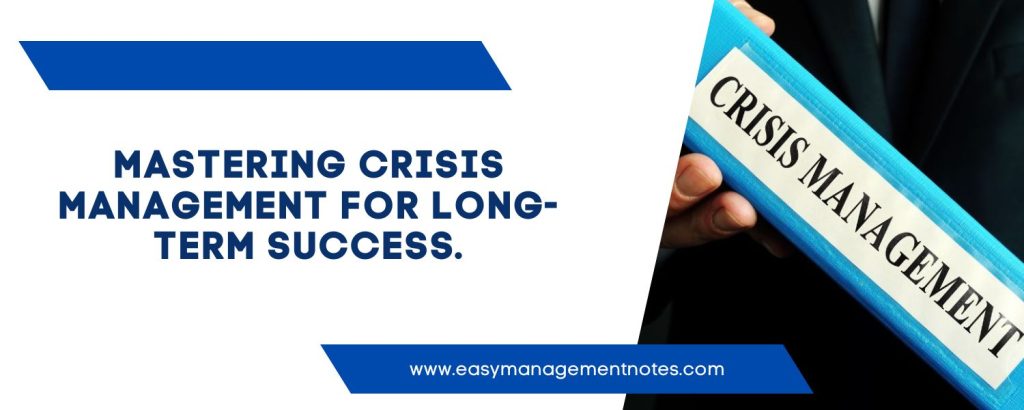
Before moving forward to crisis management, we must understand what crisis means. A crisis is an emergency condition in a business or a country. This trouble condition may last for a shorter or longer period. The crisis may appear within a short notice period.
After-effects of crises may take too long for recovery and progress. Sometimes it becomes impossible to deal with. So individuals, organizations, leaders, or country needs to be prepared with a well-trained and experienced crisis management team.
What is Crisis Management?
Analysis and preparations to deal with the expected or non-expected crisis are called crisis management. There are so many reasons for the business crisis.
A few of them are followings:
- Technology failure and breakdown
- Violence and mishappenings
- Uncertainty
- Illegal activities
- Bankrupt or insolvency
- Natural calamity
- Operational changes
- Loss in business
- Mishappening with employees/ employee
These causes may lead to a disturbance at your workplace. Only an experienced team in crisis management can help an individual, organization, or country to overcome the crisis. Sometimes organizations hire in-house crisis management teams. Also, sometimes they hire some agencies for this purpose. They pre-analyze and prepare accordingly.
Also, the crisis management team deals with unexpected crises by raising strategic steps. As a result, crisis management helps the team to prevent big losses and recover faster. Once you deal successfully with the crisis, your management staff becomes more confident to handle future business crises.
Why Do We Need Crisis Management?
Crisis management is very much important for each individual or workplace. It brings security and confidence to run a business for longer with stability and progress. Many organizations collapse due to a lack of timely crisis management services. Panics and rumors can increase the trouble at the time of crisis. The crisis management team prepares and applies strategies to prevent such nonsense activities.
It monitors media and keeps interacting with employees, clients, vendors, and more. Nobody wants to take a chance with their business growth. That is the reason why crisis management is no longer an optional element. It is a compulsory part of business management. Everyone must have a crisis management team to support the business in a time of need.
What Are The Steps of Crisis Management?
A crisis management plan works on its four essential elements: prevent, plan, practice, and perform. That means preparing preventional strategies to reduce the chances of crisis. Next, the crisis management team prepares a solid plan for the analyzed trouble. Pre-practice to tackle the situation makes your preparations more confident and error-free.
The last is performance. It tells your crisis management team must divide the responsibilities among the members clearly, and the team starts performing without wasting time. Transparent coordination plays a leading role in crisis management. Along with these four Ps of crisis management, the team needs to proceed stepwise.
Below are some crisis management steps that a crisis management plan follows for effective crisis management:
1. Crisis analysis: The team of experts keeps monitoring some external and internal activities. A few activities may lead to crises in the future. They highlight those issues and discuss them with the team members to set the action plan. They also look after the expected time of crisis appearance, duration, effects on different sectors, and more. So the first step of crisis analysis helps the management to prepare accordingly.
2. Activation protocol: Analysing the crisis doesn’t mean to start taking action now. Activation protocol is the second step of a crisis management plan where you determine your actions. Team members decide on a particular crisis level to start their action. At a trigger point activation protocol turns on the action mode.
3. Emergency contacts: You cannot take any chances during the crisis. It is more likely to lose contact with required sources in an emergency. Emergency contacts setup to the help centers strengthens your crisis management. The team includes fire help, electricians, plumbers, hospitals, and police on the emergency contact list.
4. Response process: When your activation protocol hits the action trigger, the countdown begins for the response team. According to the pre-defined roles and responsibilities, each member starts performing best of their abilities. RACI chart helps the team to work with better clarity on their respective areas of responsibility.
5. Strategy on external crisis communication: In the state of crisis, just like internal communication and cooperation, external communication is equally important. Only selected people look after the information delivery and take feedback accordingly.
6. Post crises assessment: In this step, the team looks after the achievements and failures. They update their future action plans with improvised strategies.
Only well-organized crisis management can save your workplace from disaster. So never compromise in hiring the best team for your purpose. So get the best crisis management team today to approach the heights of success. It will help you and your employees feel safe.
- Top MBA Colleges Across Asia, Europe, North America, South America, and Australia - September 28, 2024
- Creating Effective MBA Assignments: Expert Tips - September 13, 2024
- Top 10 Part-time MBA programs in the USA - August 29, 2024
